The profound growth of XR in the enterprise market has also sparked a race to deliver the top VR hardware. As immersive training grows in demand in high-risk and skill-based roles, VR headsets are lighter, more user-friendly, and steadily growing in sophistication. Although trends and statistics showcase the immense business benefits of integrating VR into corporate settings, the true magic of XR training starts the moment a person puts a headset on for themselves.
Driven by the competition to produce crisper, immersive experiences, organizations are redefining the standard for virtual reality experiences. With the freedom to choose any headset for custom VR training content, we’ve put together a comprehensive list of popular VR headsets used in enterprise environments.
Top VR Headsets For Virtual Reality Training
Choosing the right VR headset for immersive learning experiences involves an array of features to consider. From the technical aspect of cameras and sensors to battery life and design of the headset, every detail impacts learner comfort and user experience during VR training. Today’s headsets have a large focus on tracking abilities, quality of resolution, and seamless immersive experiences to ensure a smooth process without lag or choppiness. Each element dictates how seamless your organization’s XR training will be. So, without further ado – let’s jump into our list!
Pico 4E
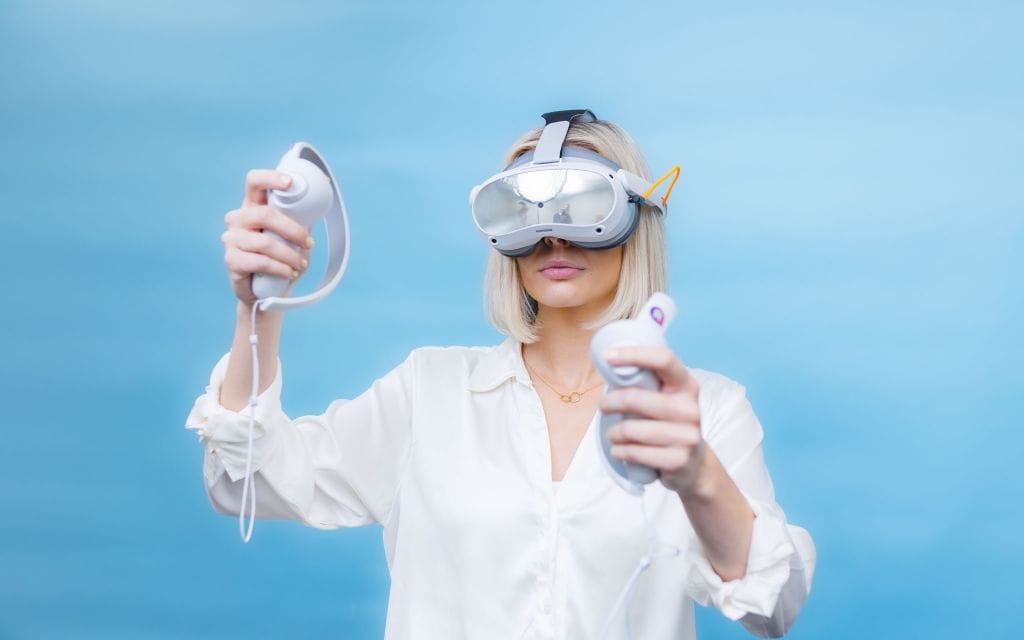
As a household name in the XR industry, Pico has earned a reputation for redefining VR quality.
Built for dynamic and immersive experiences, the Pico 4 Enterprise (Pico 4E) VR headset sets a new standard for enterprise training with ultra-clear, immersive, and lifelike XR experiences thanks to the headset’s higher resolution 1200 PPI and 4k+ display powered by the Snapdragon™ XR2 chipset.
Designed to address XR business needs, the Pico 4E virtual reality headset provides an ultra-smooth VR experience. The virtual reality headset includes an ergonomic design that includes balanced weight distribution, with the battery cleverly mounted on the back of the headset. The detachable foam mask also ensures optimal comfort for users. The Pico 4E headset also offers organizations versatility with training with cutting-edge MR capabilities.
Pico’s advanced design uses an RBG camera to unlock mixed reality (MR) experiences with video see-through. For enterprise learners, the mixed reality capabilities allow learners to perform role-specific tasks that bridge digital content with their physical work environment. With hand and eye-tracking capabilities, Pico 4E uses multiple cameras to provide inside-out 6DoF tracking that enables employees to move freely during enterprise training. This compact VR headset is a powerful yet cost-effective choice for enterprise training solutions.
With The Pico 4E Virtual Reality Headset, You Can Expect:
- High performance
- Lightweight
- Face and Eye Tracking
- Linear Speakers
- 256 GB storage and 8 GB DDR5 RAM
- High-resolution and HD display
- High refresh rates for smooth VR interactions
- “Pancake lenses” give Pico 4E a slim, lightweight design.
- 300g Weight
- Ergonomic Design for long-lasting comfort
- World Class Security
- Video Passthrough
- HyperSense Controllers with built-in broadband linear motors and haptics
Pico 4E headsets create clear, flexible interactions and immersive experiences for enterprise use cases, proving that slim, lightweight Pico headsets with powerful designs are the optimal headsets for user experience.
Pico 4E VR Headset Cost: $899
Meta Quest 3
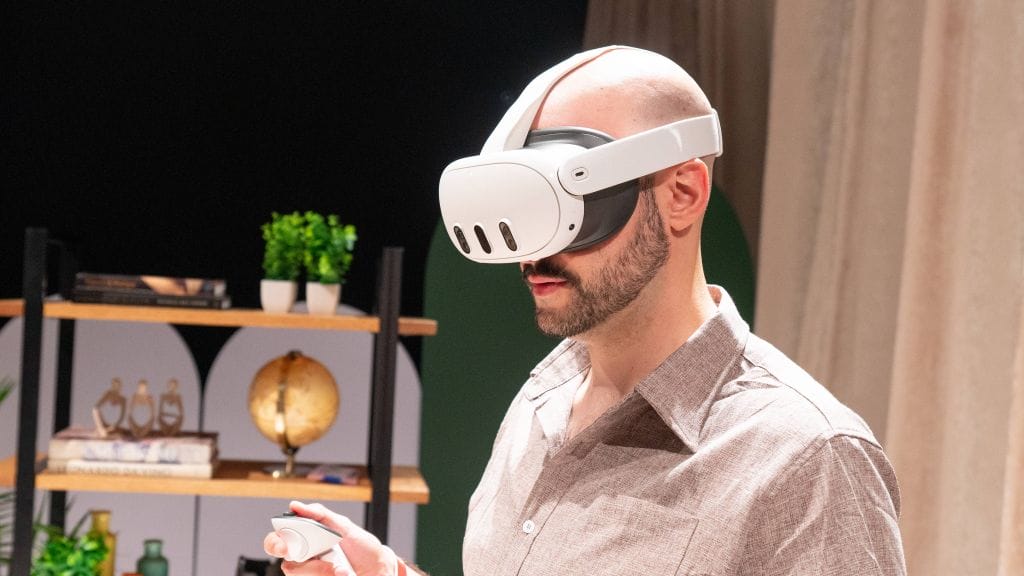
While the Meta Quest 3 VR headset was initially designed for consumers, the persistent adoption of VR in the enterprise market has influenced Meta to quickly cater to corporate training needs, pushing faster load times and much more in their most current headset.
The Meta Quest 3 VR headset is reported to have double the processing power and 30% higher resolution than their previous headset. Much like other headsets, Meta Quest 3 is also following the trend of slimmer and sleeker hardware, with a 40% thinner optic profile to optimize user comfort during virtual reality training programs for extended use.
Meta Quest 3 has also implemented the Snapdragon XR2 Gen 2, marking the most powerful technology they’ve put into a headset to ensure smooth user experiences that keep corporate learners immersed in their training. This VR headset requires a Meta account, prompting users to log in before starting their programs. According to Meta, businesses can expect a crystal-clear experience that keeps learners completely immersed in the task at hand.
With The Meta Quest 3 Virtual Reality Headset, You Can Expect:
- Redesigned Touch Plus controllers that support intuitive learning with fine-tuned precision and haptics to incorporate natural sensations.
- 30% leap in resolution compared to Meta Quest 2
- Slimmer optic profile, reduced by 40%
- 2.2-hour battery life
- Soft and adjustable straps
- Full-color, high-fidelity views with accurate depth projection and room mapping
- Price designed for teams
Meta Quest 3 Cost: $499.99
Varjo XR-4
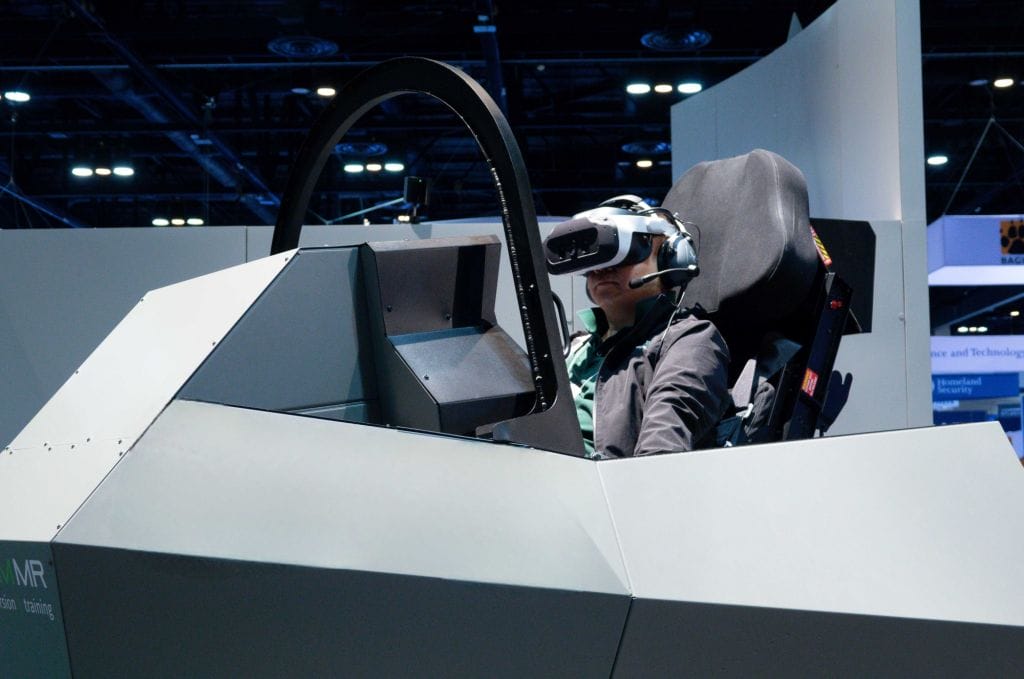
The Varjo XR-4 Series delivers best-in-class visual fidelity and is pushing mixed reality performance to the next level with superlative immersion. The Varjo VR headset is an excellent option for extremely niche enterprise applications that may require super high resolution.
Varjo’s new generation headset caters to industrial use cases where the highest-level visual fidelity and immersion are critical. With this headset, Varjo has made a radical breakthrough in optical design. With advanced MR technology and graphical processing power, Varjo XR-4 replicates true human vision with 20-megapixel cameras powering extraordinary passthrough and the world’s first gaze-driven XR autofocus system.
With Varjo VR Headset, You Can Expect:
- Field of view
- Super high resolution
- High graphic quality application – resolution is way higher than any headset
- Higher field of view
- Inside-out tracking and Varjo controllers with premium ergonomics
- TAA Compliant
Varjo XR-4 Cost: $3,990
Varjo XR-4 Focus Edition Cost: $9,990
HTC Vive Focus Series
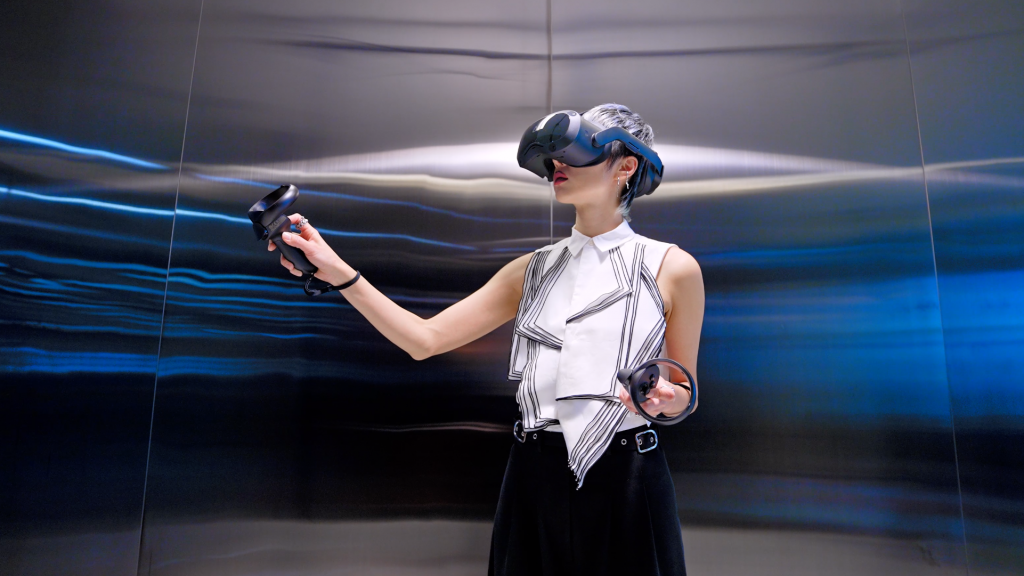
Experience the future of immersive technology with the HTC Vive Focus 3. This all-in-one solution combines cutting-edge hardware to deliver exceptional virtual reality experiences.
The Vive Focus 3 has the power endurance for any business application.
With The Vive Focus Series, You Can Expect:
- High-resolution Displays
- Versatile Tracking Features
- High fidelity hand-tracking
- Immersive Business Applications
- Standalone All-In-One VR Headset
- Sharp 5K Resolution
- 120 wide field of view
- 90Hz refresh rate
- 15 hours of battery life and USB charging support
HTC Vive Focus 3 Cost: $1,300
Apple Vision Pro
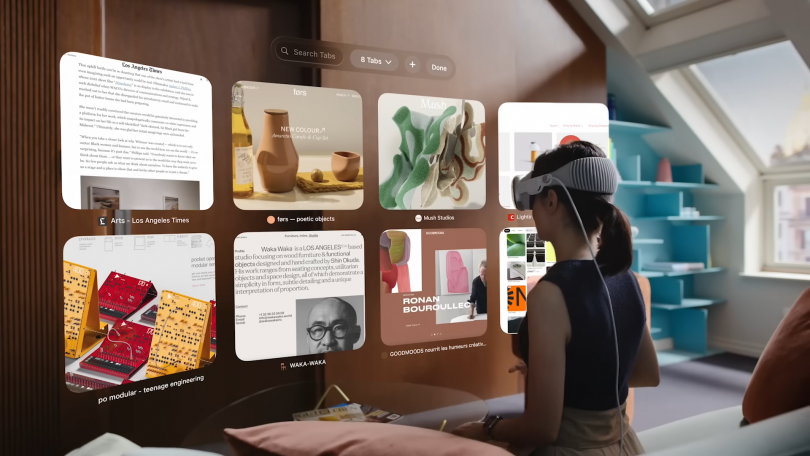
While the Apple Vision Pro isn’t a VR headset, it still made the list! Don’t worry – we’ll explain. The Apple Vision Pro is a spatial computing device that has all the capabilities of a high-end Mac – plus more. So, how will it seamlessly enhance the flow of work? Employees can use the same suite of apps they might use on a computer to collaborate on documents in real-time. Users simply navigate the Apple Vision Pro with their eyes, hands, and voice.
The Apple Vision Pro seamlessly blends digital content with the physical environment using a spatial operating system. As developers explore the potential for enterprise use cases, the initial impression of the Vision Pro is that the device is well suited for office settings and could foster more collaboration amongst the hybrid workforce via videoconferencing. Underscoring the promising future of spatial learning, the Apple Vision Pro utilizes passthrough so that users can see apps overlayed in their real-world environment, similar to a wearable augmented reality experience.
Designed primarily for consumer use, Apple fans will delight in Apple-centric amenities as the device takes iPhone features and applies them to immersive experiences. From familiar icons that can be selected with the user’s eyes to panoramic photographs turned into an immersive experience. The most distinguished feature may be dimensional hyper-realistic spatial photos and videos. The digital crown button allows users to adjust their level of immersion in different scenes as well as adjust volume, recenter content, and access settings.
With The Apple Vision Pro Virtual Reality Headset, You Can Expect:
- Use case for working in the office for corporate settings
- Eye tracking that allows your eye to work at a curser
- Spatial Audio
- 3D Spatial Video and Pictures
- Two high resolution main cameras
- Six world facing tracking cameras
- Four eye tracking cameras
- TrueDepth camera
Apple Vision Pro Price: $3499
Lenovo ThinkReality VRX
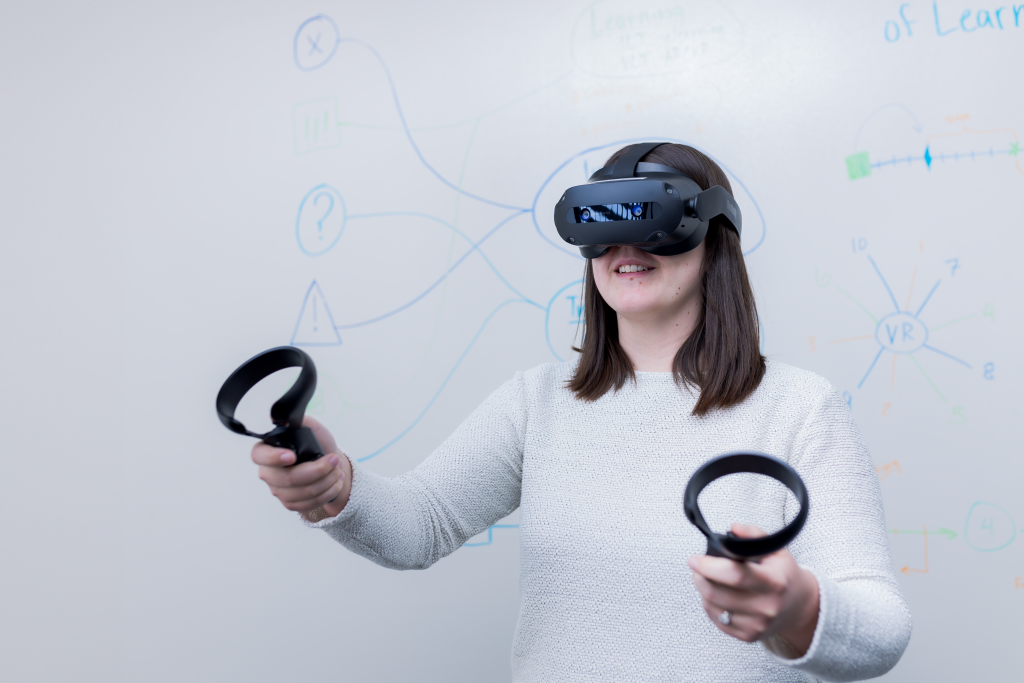
Engineered for enterprise use, the Lenovo ThinkReality VRX all-in-one headset tackles the challenge of scaling XR solutions in enterprise spaces. Lenovo’s persistence to improve its VR headset is likely to impact the success of its hardware as an enterprise solution.
With Lenovo’s ThinkReality VRX, You Can Expect:
- Lightweight and slim profile with six degrees of freedom (6DoF).
- A full suite of end-to-end services to help organizations achieve success and realize ROI faster
- Powered by Snapdragon® XR2+ Gen 1 Platform
Lenovo ThinkReality VRX Price: $1,300
Selecting The Right VR Headset For Your Corporate Training Program
While there are unique benefits and characteristics of each device listed above, selecting the right VR headset for your training program will ultimately depend on your use case. Popular use cases for VR headsets include onboarding and scenario-based training where learners are still in the initial training stage. As learners practice foundational training concepts, virtual reality training is great for training on anything that is too dangerous, too expensive, or too inconvenient to train on.
Virtual reality training is not for everything. For example, VR is not compatible with just-in-time training, which is better suited for augmented reality. While passthrough on select VR headsets can unlock mixed reality, the innovative feature can impact slight delay from what the camera is seeing and what’s being rendered onto lenses, making hand movement a couple of milliseconds behind. This is important to consider for tactile skill acquisition. One major takeaway from the competing enterprise headsets is that learner comfort must be prioritized.
As VR headsets quickly evolve to compete in serving enterprise training needs, Pico 4E and Meta Quest 3 are the best standalone devices for scalable immersive learning solutions. Between the top contenders, Meta’s brand recognition competes with Pico’s successful history of designing headsets for enterprise use. At the top of the budget pyramid is Apple’s Vision Pro – an excellent office-centric solution that will help optimize hybrid work. For organizations that are looking for a niche VR headset that caters to higher-end graphics or fields of view, Varjo is a top pick. Ultimately, the most differentiating factors between the top VR headsets are price and IT infrastructure.
Explore VR Training
Is your organization ready to unlock a new dimension of possibilities? VR headsets are sleeker and more powerful than ever before, proving to be an organizational asset that optimizes learning and development initiatives.
Explore use cases for VR training today! The top-performing VR headsets are a massive investment in workplace safety, skill acquisition, and operational success. Virtual reality headsets, spatial computing devices, and wearable augmented reality are shaping the future of XR for enterprise use. Give them a try yourself!








